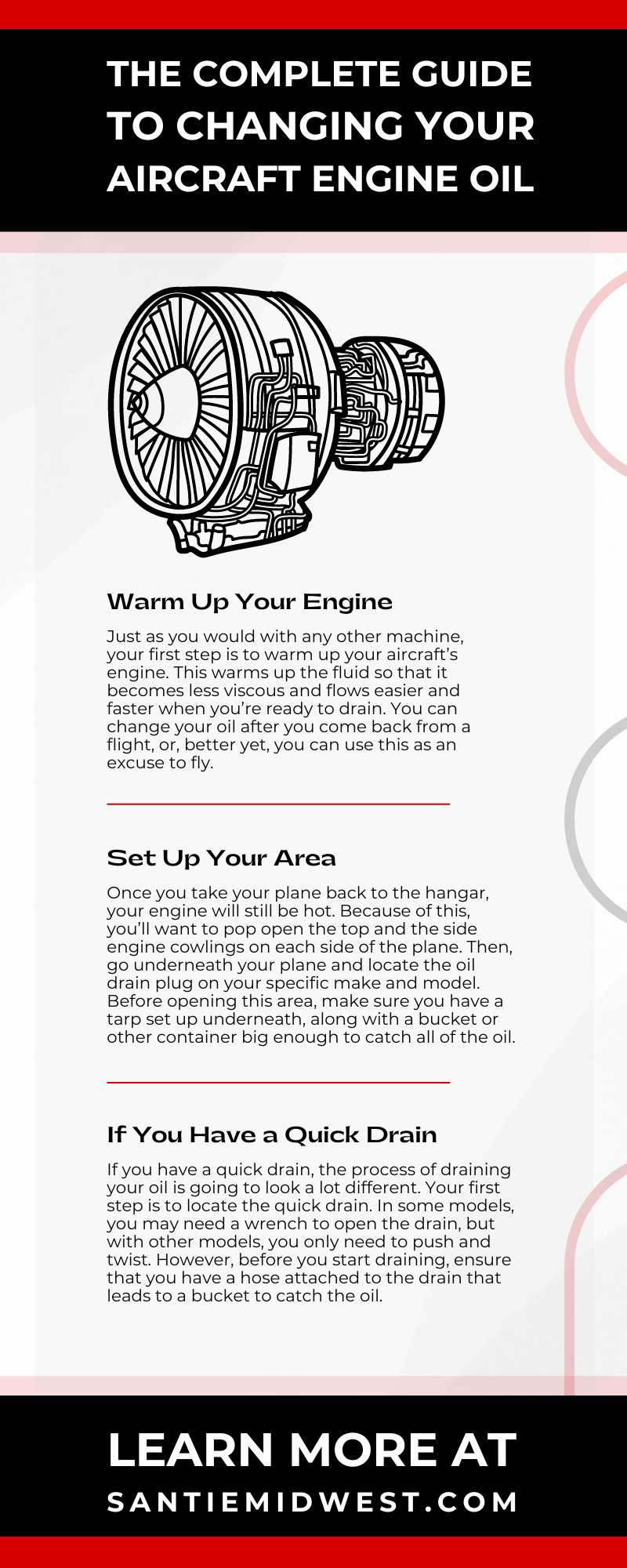It may seem like just another time-consuming maintenance task, but changing your aircraft oil is an important part of keeping your machine healthy. Eventually, chemical additives within the oil begin to break down, and your oil will lose its ability to protect your engine over time. However, the main purpose of oil changes is to check for and remove contaminants that can lead to premature failure.
If the thought of changing your own oil is a little intimidating, you’re not alone! Let the experts here at Santie Oil walk you through this in-depth, step-by-step guide to changing your aircraft engine oil.
Warm Up Your Engine
Just as you would with any other machine, your first step is to warm up your aircraft’s engine. This warms up the fluid so that it becomes less viscous and flows easier and faster when you’re ready to drain. You can change your oil after you come back from a flight, or, better yet, you can use this as an excuse to fly.
Set Up Your Area
Once you take your plane back to the hangar, your engine will still be hot. Because of this, you’ll want to pop open the top and the side engine cowlings on each side of the plane. Then, go underneath your plane and locate the oil drain plug on your specific make and model. Before opening this area, make sure you have a tarp set up underneath, along with a bucket or other container big enough to catch all of the oil.
If You Have a Quick Drain
If you have a quick drain, the process of draining your oil is going to look a lot different. Your first step is to locate the quick drain. In some models, you may need a wrench to open the drain, but with other models, you only need to push and twist. However, before you start draining, ensure that you have a hose attached to the drain that leads to a bucket to catch the oil. There are too many parts surrounding a quick drain, and you risk spraying oil everywhere if you don’t use a hose. The good news with quick drains is that you don’t have to remove any safety wires or drain plugs.
Remove the Safety Wire and Drain Plug
If you don’t have a quick drain plug, you’ll first have to remove the safety wire from the drain. Before moving on, make sure you have your catch container ready because when you remove the drain plug, it will come pouring out quickly. Hold up your container, twist the drain plug, and catch all the oil flowing out of it. Be sure to put your drain plug in a safe place because you’ll need to reuse it later.
Catch an Oil Sample
As your oil flows, take a small plastic container and catch an oil sample. You need only about four ounces. However, you want to catch your sample while the oil is flowing to avoid getting any contaminants in the sample. You can send this sample to an oil sample analysis lab. They can tell you how healthy your engine is and get a baseline for what your aircraft engine should be.
Cut Your Filter’s Safety Wire
Once you’ve finished draining the oil, you can move on to the filter, which should be under the cowls you opened earlier. Much like your drain plug, your oil filter also has a safety wire that you need to cut to remove it. Most engines have a spinning filter you can twist on, and the wire goes over the canister and through the adapter.
Cut off the safety wire and remove your old filter, but don’t throw it away yet! We’re going to inspect it later on. You want to let your oil filter drain for a day.
Grease Your New Filter
After you cut your safety wire, you can take a torque wrench to twist off the canister. Just be sure to place some paper towels and cardboard underneath to catch any drippings of oil that may spill out. Before placing your new filter, write the date and time on it, and spread a fingertip’s worth of grease around the gasket ring. This creates a solid seal and makes twisting on the new wrench easier.
Switch Out Your Filters
Now that you have your new filter greased and ready to go, you can place your new oil filter and twist it on until it touches the gasket. Then, you’ll want to take out your trusty torque wrench and tighten the oil filter until it clicks.
Once you have it in place, you can put on your safety wire—ideally stainless steel safety wire. Thread the wire through the back hole of the oil filter adapter, loop it around the canister, and pull it taut. Then, twist the wire strands together to make a tight braid.
There should be a hole on the top of the canister to thread the other end of the safety wire through. Thread it through, twist it, pull it tight, and cut off the rest of the wire so that there’s an inch or two left at the end.
Put a New Safety Wire on Your Drain Plug
Your next step is to go back under the plane and start working on putting a new safety wire on your drain plug. It may be difficult to see at first, but there’s a small hole on top of the drain plug hole itself where you can thread the safety wire through. Then, grab your old drain plug and check if the crush washer is still on it. If it’s not and you can’t find it, you must replace it before putting on a drain plug.
Twist on your drain plug until it’s nice and tight, grab your 7x8 inch wrench, and make sure your drain plug is nice and snug. Then, cut off some of that excess safety wire, pull the ends taut, and make another tight braid. The safety wire should go through the pan and the bolt, essentially pulling the plug in a tightening direction.
Replace Your Oil
Now that you have your drain plug and filter in place, unscrew the cap from the oil filler neck with a paper towel in hand to catch any oil from the dipstick. If your oil doesn’t have a neck on the bottle that makes it easy to fill, you can wedge a funnel in the filler neck against the dipstick. Then, pour the oil in, put the dipstick back in the filler, and twist it clockwise until it’s nice and snug.
Inspect Your Filter
Remember how you let your old oil filter drain for a day? Now you can open the canister and inspect the filter. Fortunately, there are oil filter wrenches you can use to twister the filter off. Take the paper filter, cut around the bottom so that you can take it apart, and grab a magnet. Run the magnet along each pleat in the filter to ensure there’s no metal. If there is metal, put the filter in a Ziploc bag and take it to your mechanic ASAP.
With this complete guide to changing your aircraft engine oil, you can hopefully save money on oil changes and keep your airplane engine running like new. If you’re looking for high-quality aviation lubricants, shop at Santie Oil today. As a lubricant wholesaler, we have everything you need to keep your aircraft in top shape so that you can fly in peace.


